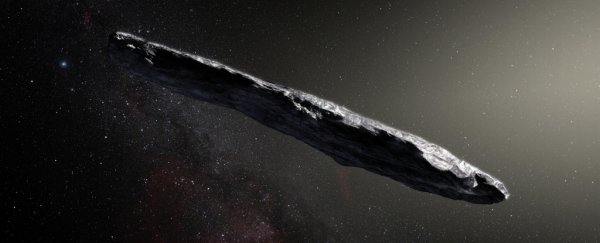The first known interstellar visitor to our Solar System, 'Oumuamua, which buzzed past the Sun last September, has proven evasive to define. First it was a comet. Then it was an asteroid. Then it was maybe both.
Now a new team of researchers led by the European Space Agency has delivered their verdict: 'Oumuamua, according to their analysis, is probably a comet after all.
If you have whiplash, you're not alone - but on the other hand, its interstellar origins notwithstanding, 'Oumuamua is unlike any object we've ever seen before.
It was first spotted on October 19 last year, 40 days after it had already made its closest approach to the Sun, and it immediately got scientists abuzz. Its velocity indicated that it had come from somewhere far outside our Solar System - and that it had been travelling for hundreds of millions of years.
It was also an unusual shape - up to 400 metres (0.25 miles) long, and distinctly cigar-shaped. It could be up to 10 times as long as it is wide - which was never before seen in an asteroid or comet.
Figuring out whether it's an asteroid or a comet, however, has proven extraordinarily tricky. At first, based on preliminary observations, astronomers thought it was a comet. But comets contain ice, the sublimation of which creates the tail as they zoom through space.
'Oumuamua showed none of the characteristics associated with comets. It was reddish in colour, and showed no signs of dust around it - indicating that it was composed of dense rock and metal, reddened by cosmic radiation, and contained no water or ice.
In December, a team of researchers announced that 'Oumuamua's organic-rich crust could conceal a comet-like icy core - concluding that the object is a planetesimal with a well-baked crust (it sounds like a delicious pie now).
But, according to ESA astronomer Marco Micheli and colleagues, there's one more aspect that seriously seems to indicate comet, and it hadn't yet been factored in.
'Oumuamua's trajectory.
The international team analysed both ground- and space-based observations of 'Oumuamua as it traversed our Solar System, and they found something strange. Its arc could not solely be explained by the effect of gravity exerted by the Sun or other objects. Which means it seems to be behaving… like a comet.
"The motion of all celestial bodies is governed mostly by gravity, but the trajectories of comets can also be affected by non-gravitational forces due to cometary outgassing," the researchers wrote in their paper.
They detected non-gravitational acceleration, mainly directed away from the Sun, in 'Oumuamua's trajectory. This may not have been caused by cometary outgassing, but it is consistent with the behaviour of comets.
Just to be sure, the team carefully examined other potential causes, including things like solar radiation pressure, various external forces, and interaction with solar wind. They even accounted for "geometric effects" which could happen if 'Oumuamua wasn't one solid object, but several chunks flying together.
After all that, they concluded "comet-like outgassing to be a physically viable explanation, provided that 'Oumuamua has thermal properties similar to comets."
As for the lack of dust cited as a reason for 'Oumuamua's asteroid designation, the team noted that this could be explained by an atypical dust-grain size distribution, a low dust-to-ice ratio, or changes to the object's surface sustained over its long journey from its mysterious origin point.
If it is a comet, that would have an impact on 'Oumuamua's hypothesised origins. A study earlier this year found that its most likely starting point was a binary star system, since that would be the most likely to eject an asteroid, as opposed to a comet, which apparently the Solar System flings about into interstellar space willy-nilly.
It may actually be impossible to tell whether 'Oumuamua is a comet or an asteroid based on our current observations. However, it's moving away from us at speed, and we've probably missed the boat to send a probe to study it in situ.
But, if there's a next time - another interstellar visitor in the future - our understanding could benefit greatly from knowing about it ahead of time, and having the infrastructure in place so that we could intercept it with a probe.
Whether such a visitor is similar to 'Oumuamua or vastly different, these observations could help us understand the physical properties of interstellar objects - and how much of 'Oumuamua's uniqueness is because of its long, lonely and possibly violent journey through the vastness of space.
So who votes for hedging our bets and calling it a cometsteroid?
The team's research has been published in the journal Nature.
